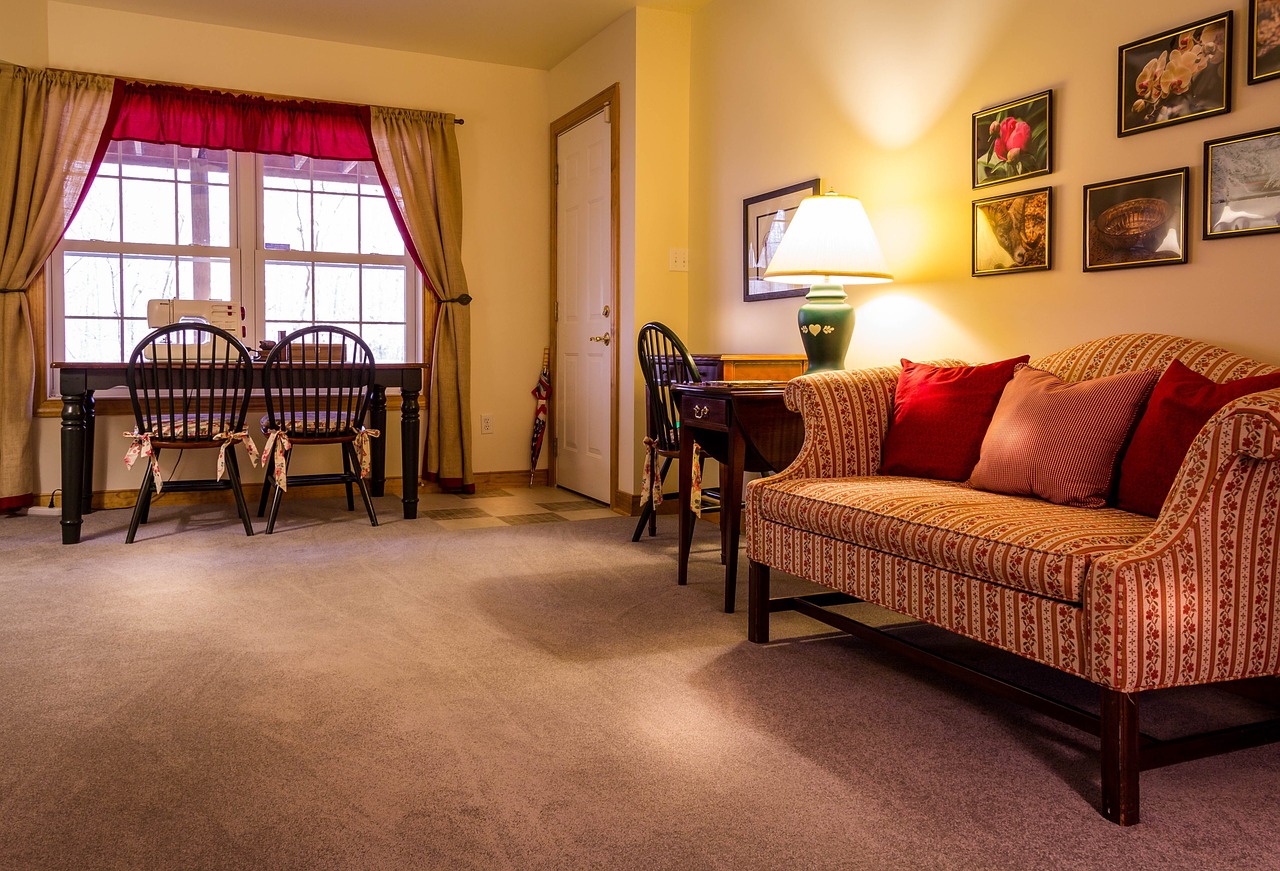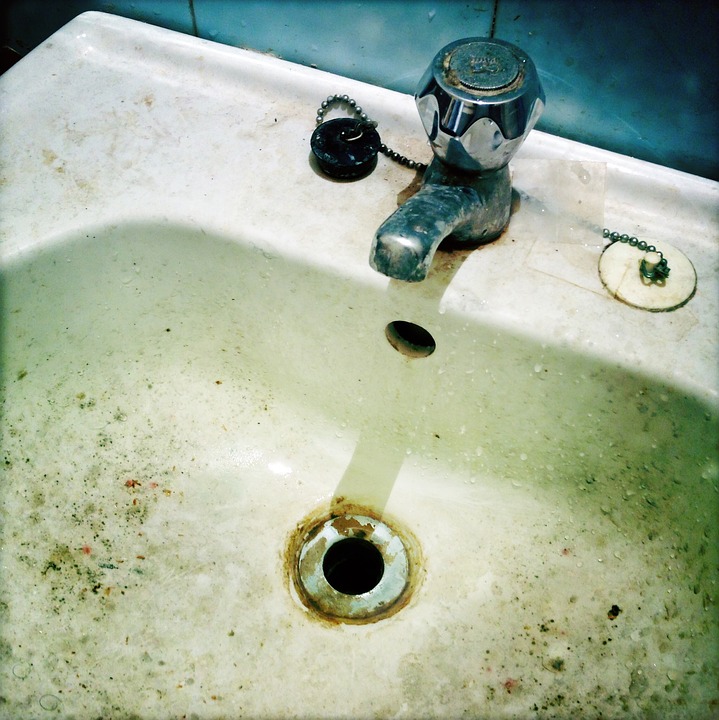Steps for Decluttering your Home
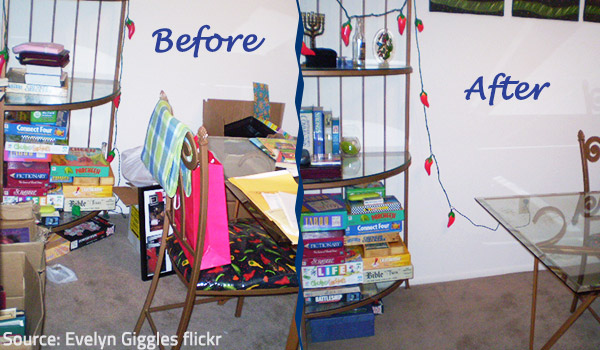
Decluttering works like a magic spell – your messy home will transform into a neat haven.
Have you ever lost half an hour searching for a certain item that should be right there but for some mysterious reason it was not? The chances are that no black hole had suddenly appeared in your house, so probably you just misplaced the piece and couldn’t locate it in all the clutter you willingly or inadvertently created in your home. If you kept each possession of yours exactly where it belongs, you would never lose precious time rummaging through your belongings until you find what you need and, besides, your place would look tidier, nicer, and much more attractive. This achievement is just one effort away – all you need to do is declutter your home.
Why Is Home Cluttering Such a Common Problem?
While cluttering is typically ascribed to unorganized people, there are two major reasons for crowding your home with too many items – either the available space is not enough for your needs or you just can’t let go of no longer needed things.
Space-Related Issues
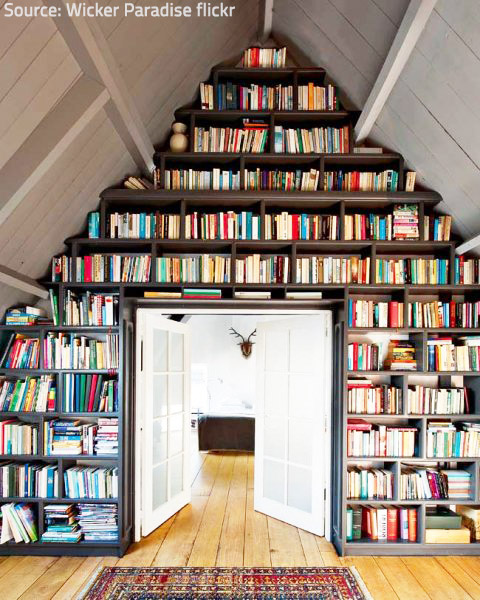
You will need to come up with clever tricks to expand your available space.
If your home is small and your family is large, it is only logical that sooner or later you will be faced with a cluttering problem. Every family member needs a variety of personal belongings and when they are added up to the common necessities, such as all the furniture and appliances, your home may easily turn into a big mess. If you can’t afford to upsize your home, maximizing the available space is your only option – find out some little tricks which will allow you to use the vertical space in your home, the areas under the stairwells or above the doors, etc. Use your imagination as the force behind your decluttering strategy.
On the other hand, having too much space can result in cluttering too – why bother sorting your items when there is enough room in your home for all of them? You may even forget that you have kept a certain piece – it may be safely stored out of your way but time will slowly render it valueless and you will find yourself surrounded by useless junk.
Especially when a family has inhabited the same house for generations, the accumulated items might have slowly taken up all the living space – such an environment can be fun to explore because it will be full of treasures of old but it will be a real challenge to live in. Your only option is to learn how to declutter your home quickly and efficiently.
Sentimental Issues
People often associate material items with happy experiences, beloved persons or nostalgic memories. It is really hard to give away keepsakes – children’s artwork, old framed photos, outdated items from a past life, etc. – all this useless stuff often seems to be more valuable than the most expensive modern pieces.
When it comes to decluttering your home, you may feel frustrated to get rid of an item reminiscent of something important or someone special. However, keeping half-broken and nonfunctional objects will not cause past times or late people to return. You are entitled to the memories but they will stay with you even if you discard the associated items. Or at least, try to keep just a couple of them – ones that still evoke powerful emotions (one toy that your kid really enjoyed, one love-letter that made you cry from happiness, one souvenir from your honeymoon, one of your grandmother’s hand-woven rugs – just one of a kind to stand for the entire group).
To be able to enjoy a neat and clutter-free home, regardless of the available space and your sentimental attitude, you need to organize your items in a tidy and systematic manner and to make every effort to maintain the system.
Steps for Decluttering your Home

Decorative items are intended to add charm and appeal to your home, not to create chaos.
Cleaning out clutter is not necessarily a tedious and painful process. Just follow these simple steps to get free of the annoying problem once and for all.
1. Make the Decision
Talking about how much you dislike clutter will do you no good. Just take the matter in your hands and decide to put an end to all the unnecessary frustration caused by the chaos in your place. Don’t try to fool yourself with the promise that you will address the matter tomorrow – tomorrow never comes. Make a firm decision that you want things to change and get down to work! You will have greater success if you don’t waste too much time on the process – spare 30 minutes a day on the decluttering task, no more. Just do it every day! Restoring order quickly will bring you so much satisfaction that once you begin, you may find it difficult to stop.
2. Find the Fine Line between Clutter and Décor
It is very tricky indeed to draw the thin line between a collection, a clutter, and eventually a hoard. Decorating your home with lovely items adds coziness and charm to the surroundings but having every available inch of space filled with knick-knacks, collectibles, memorabilia, and kitsch is neither pretty nor practical. If you cross the line, your home will turn into a messy storage unit and there is no way you could enjoy that! When adding something to your collections, your decorations, or your belongings in general, think in perspective. Consider how practical, how valuable, and how nice this item really is. Then, have a look at the existing clutter and remember that you don’t need anything duplicate, broken, or outdated, especially if it is not one of the special sentimental objects. Don’t be so terrified to lose things you neither use nor like – keeping them just for the fun of it is not great fun after all.
3. Get Supplies
When you prepare suitable materials to complete a task, you actually prepare mentally to bring it to a successful end. So, before starting the painstaking decluttering process, get hold of five large sturdy boxes. The boxes are not really important but their symbolical role is very crucial.
-
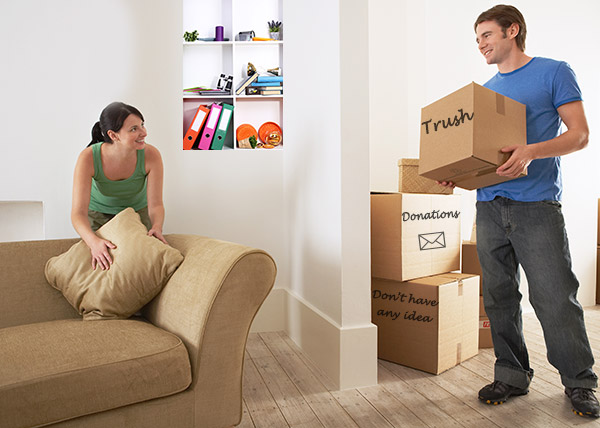
Make a firm decision, provide sturdy boxes and get down to hard work. Well, decluttering is not such a tough task, after all.
Label one of the boxes “Trash” to place inside it everything that you intend to throw away;
- Label the second one “Treasures” to store inside it all the useful and enjoyable items you are definitely going to keep;
- Label the third one “To their rightful place” for all the items that have been misplaced;
- Label the fourth one “Donations” to keep everything that is in good condition but you don’t need it any longer;
- Preserve the largest box available for “Don’t have any idea” and try to get all the things you are not sure what to do with inside (remember – just one box, be it really gigantic!).
4. Rearrange the Space to Make Sense
When your boxes are all lined up, spare a moment to give the entire process some heavy thought. Before organizing your stuff, make sure you know where you want every single item to be. Look around each of your rooms and decide what its true function is – no matter whether it is called a “dining-room”, if you use the space to relax with your entire family in the evenings and play board games or watch movies, then the “dining room” should be equipped correspondingly with your home theater set, DVDs, game consoles, board game sets, and so on. Declutter from the perspective of future functionality and use the opportunity to rearrange your home according to your actual needs and preferences and make sure it reflects your taste and your lifestyle, not some general standards.
5. Start with an Easy Area
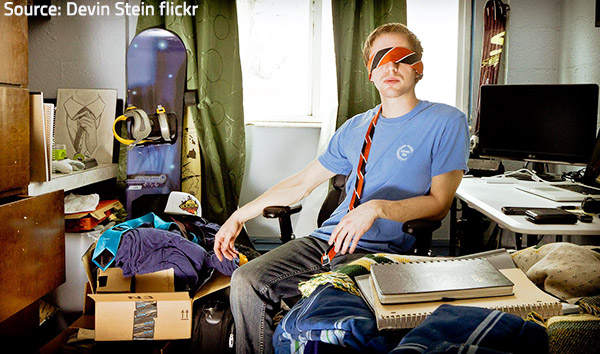
Closing your eyes and pretending that clutter doesn’t exist will do you no good.
Some places are more difficult to declutter than others, so choose an easy area to begin your endeavor. For example, declutter your medicine cabinet first: it is really easy, just throw away all the medications that are past their expiration date or half-used and unlikely to survive until the next time when someone will need them. Your kitchen cabinets and your bathroom vanities are other easy starting points because you certainly don’t keep items of sentimental value in there – just tidy these areas and get rid of anything worn out, damaged or unnecessary.
Another successful approach is to start cleaning out clutter from the areas where it presents a real obstacle or irritates you the most. Not being able to open your jewelry box, for example, because of the countless “beautiful” decorations on top of it can be annoying. Not being able to invite friends over because you feel embarrassed by all the clutter in your guest room is also annoying, right?
6. Set a Golden Rule – “A Cleared Spot A Day Keeps Clutter Away”
It is your consistency that predefines your success or your failure. Be it only one counter, one shelf, or one cabinet, just declutter a small area of your home every single day and you will find yourself in a place free of clutter in no time, almost effortlessly. All you need to do is empty the area completely and sort all the items in one of the five boxes described above. Deal with boxes 1 – 3 immediately and keep boxes 4 and 5 for later (remember that you should take the contents from all 4-numbered boxes to a donation bank at the earliest opportunity). Store the boxes with uncertainties out of your way – in a garage or an attic, so that they don’t trouble your daily life any more.
7. Make It Fun
Cleaning out clutter can be easily transformed into a game. You have several options, especially if your children are at an appropriate age for playing games. You can always invite friends over to participate, as well.
-
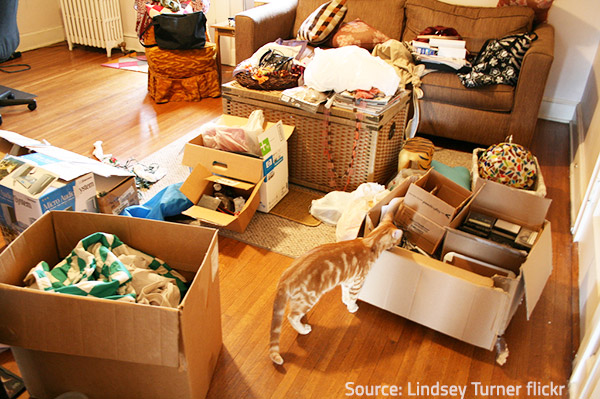
Your kitty would also like to partcicpate in the decluttering games – only if you reward it with a nice treat.
The most popular decluttering entertainment is a kind of a hidden object game – “Who will find 10 things that are not at their rightful places?” (Bonus points should be given to the person who finds the places in question too.) The winner gets to decide the fate of one of the items you are not sure what to do with. Or even better – they can keep their favorite pieces from among the misplaced ones;
- Another very beneficial option, especially when young children are involved, is “10 old items are worth one new”. It is very efficient, just promise your children that if they give up ten old things they don’t like/need/want anymore, they will receive a new one. Soon enough, ten half-broken toy cars, for example, will give way to a brand new car (just ONE). The same principle is valid for your clothes and shoes too – 5 pairs of worn out or uncomfortable shoes that you keep for no good reason can be replaced with a trendy new pair. Sounds good, right?
- Organize a quiz: “Who can think of the funniest memory associated with a certain item?” Make a list of the memories and award the winner with one of your charming decorative pieces. If none of your family members and friends has come up with a good memory related to a specific object, it is a sure sign that the time to get rid of it has come;
- Throw a decluttering party – provide some snacks and drinks (or home-made delicacies), play rhythmic music and let your family and several close friends have some fun messing the place at will and then discarding everything useless and organizing the mess.
8. Reward Yourself for Every Decluttered Room

Do you honestly believe that you deserve a reward for this room?
When you finish a major decluttering project (the entire bedroom, for example), reward your efforts accordingly – take your family out for dinner, go to the movies, spend a day at the beach or visit the nearest amusement park, anything that brings you pleasure will do. The idea is to associate decluttering your home with positive emotions. This is a powerful stimulus indeed.
9. Enjoy Your Free Space
You will certainly find your decluttered home really convenient and its tidy look very appealing but the free space may prove to be much more beneficial than you have thought. With the expansion of your clutter-free zone, there will be enough space for you to have a dance party or to exercise regularly, for example, for your kids to build an entire Lego town, for cheerful pets to play and lovely house plants to grow, etc. You will actually be able to indulge in new activities that the clutter has rendered impossible until now.
Once you have achieved a non-clutter zone, make sure to never violate it – the temptation to replace one kind of clutter with another is usually very strong. Enjoy every inch of your hard-earned freedom and fight to preserve it!
10. Address the “Don’t Have Any Idea” Boxes
Now that you have begun to love your clutter-free home, the time to deal with the variety of items you are not sure what to do with has come.

Sooner or later, you will have to decide the fate of every item.
In case you are one of those people who preserve stuff they no longer need, just because they may need it again in the future, consider the following: “If you want to keep them, you will need to rent a storage unit because your home is not large enough to hold everything that you may eventually need someday. Time, however, is merciless and this item may get damaged or outdated by the moment you need it (think of a non-digital camera, for example). Besides, the money spent on the storage unit will be enough to get a new modern piece if you ever really need one.” It’s solid logic – discard everything you don’t use!
Many of the items in the final box, however, will be invested with sentimental value – the most common reasons to keep a useless piece are associated memories of happy times or love and respect to the person who has given it to you. You just need to believe that discarding a certain item does not mean discarding your feelings towards a dear person or your cherished memories or your past experiences. The item is nothing more than a reminder and you hardly need material reminders but if you still have second thoughts, put all these uncertain objects to a test. Arrange them in a box, seal it and mark the date, then store it away. After about a year, answer the following question: “Did you feel the need to open the box, even once?” – If not, get rid of it immediately; if yes, preserve only the specific items you missed and searched for in the box and get rid of the others. Also, as already mentioned, remember that keeping one representative of a group of items with similar sentimental value will ensure your peace of mind.
11. Maintain
Deep house cleaning is often required after decluttering your home to fully restore the pleasant atmosphere inside your property. After having achieved a success, make an effort and keep it that way:
- Never put an item where it doesn’t belong and teach your children (spouse, roommates) to do the same;
- Donate useful items that you don’t need or don’t like, regardless of who gave them to you – they can serve a better purpose than being stored, forgotten, and covered in dust;
- When you want to buy a new item, make place for it by losing an old one;
-
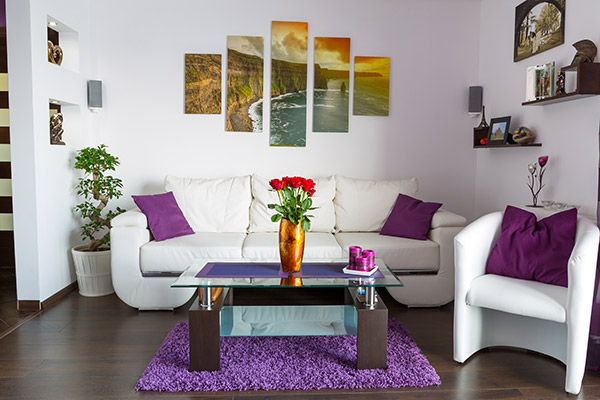
Enjoy your clutter-free home!
If you are not ready to replace an old piece, just don’t buy a new one yet (unless it is really necessary, of course). Put it down on your “wish-list” and wait for about a month – if it is still on the list after 30 days, go and buy it. However, it often happens that with time, people lose the urge to buy a specific unnecessary item and save a lot of money and clutter.
Your life will be easier without clutter, so stick to the rules:
- Sort out your belongings, get rid of the unnecessary ones and keep the practical items organized;
- Don’t cross the fine line between decorations or collections and clutter;
- Don’t turn your home into a tomb of memories and treasures of old.











